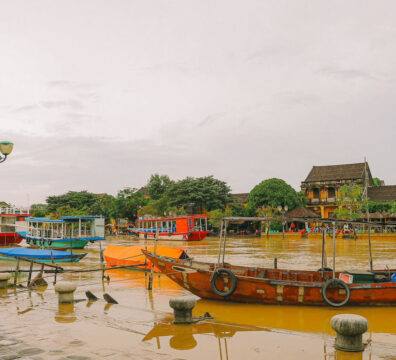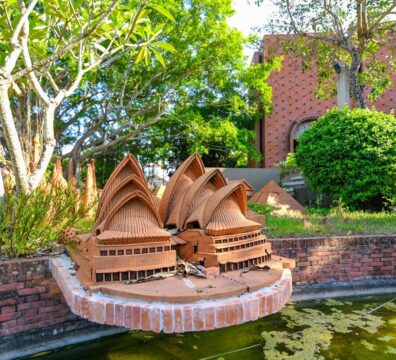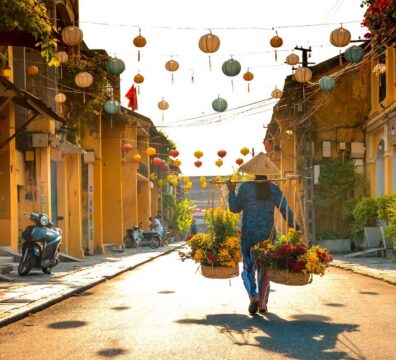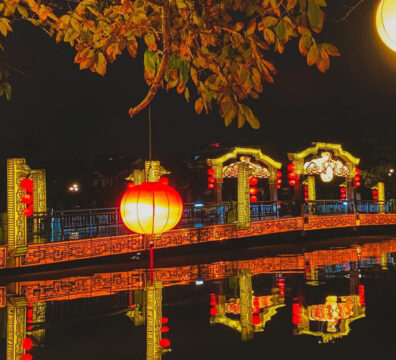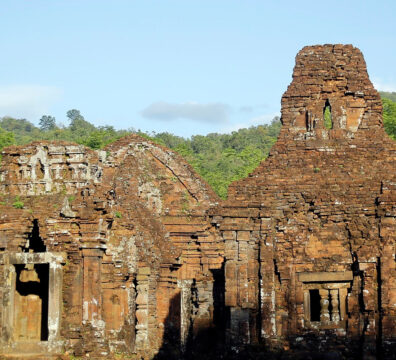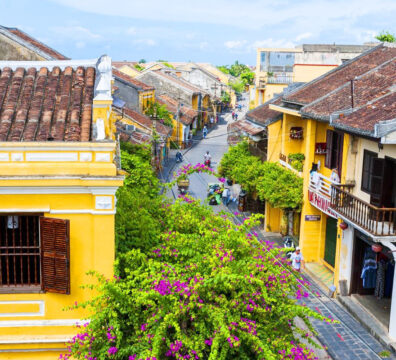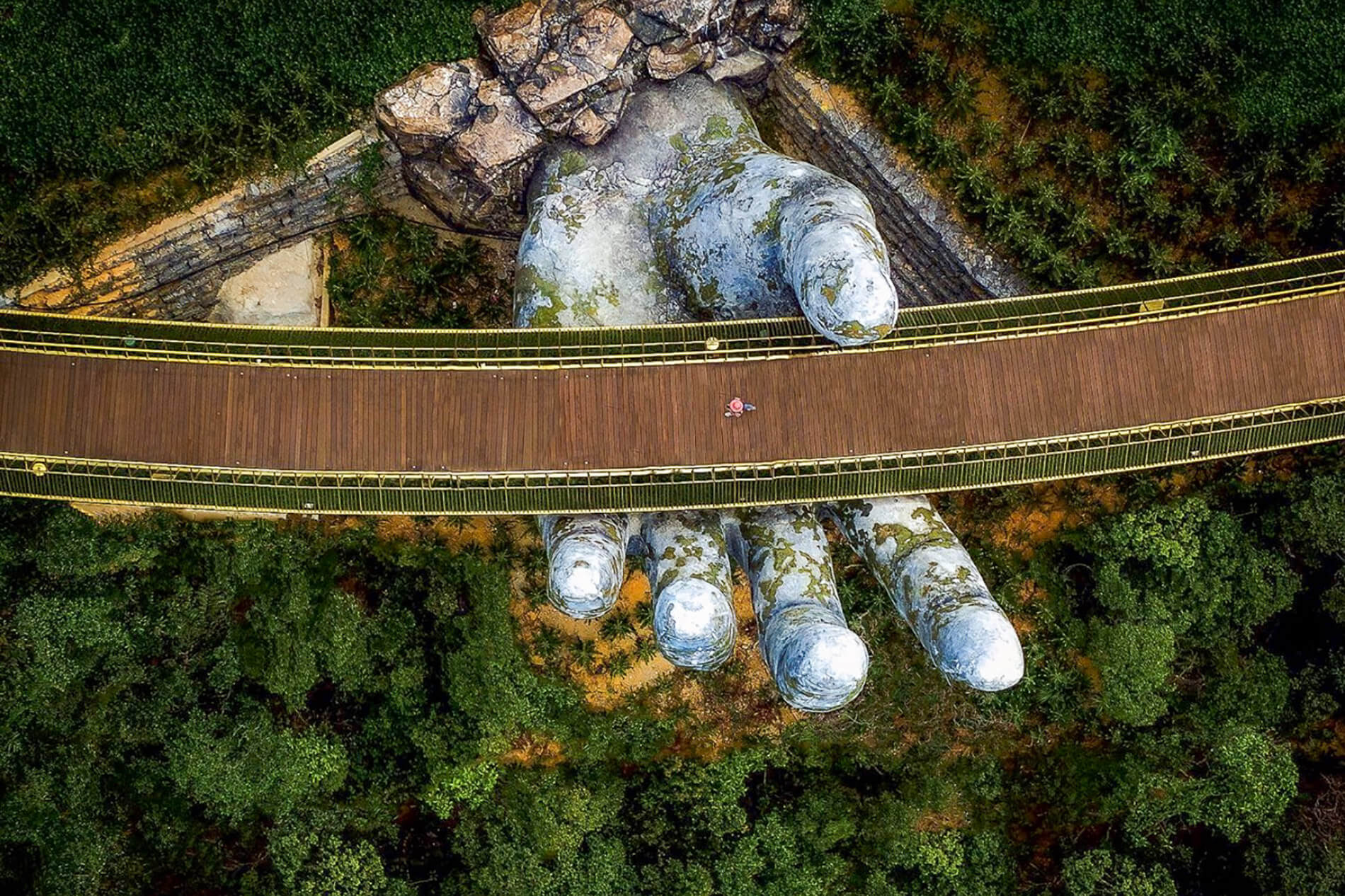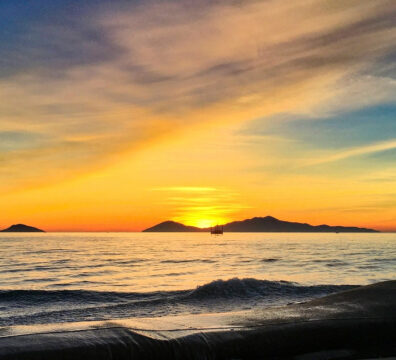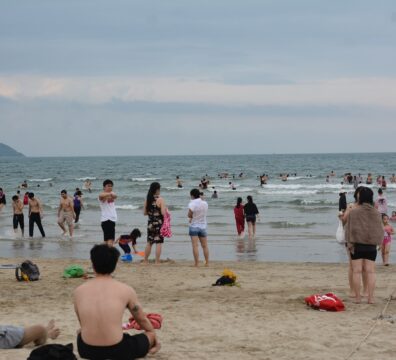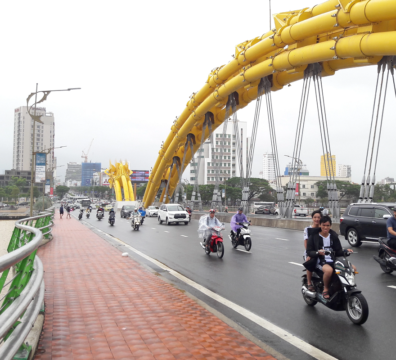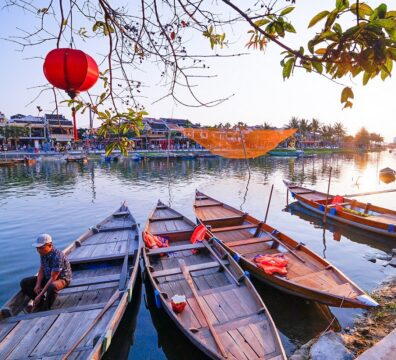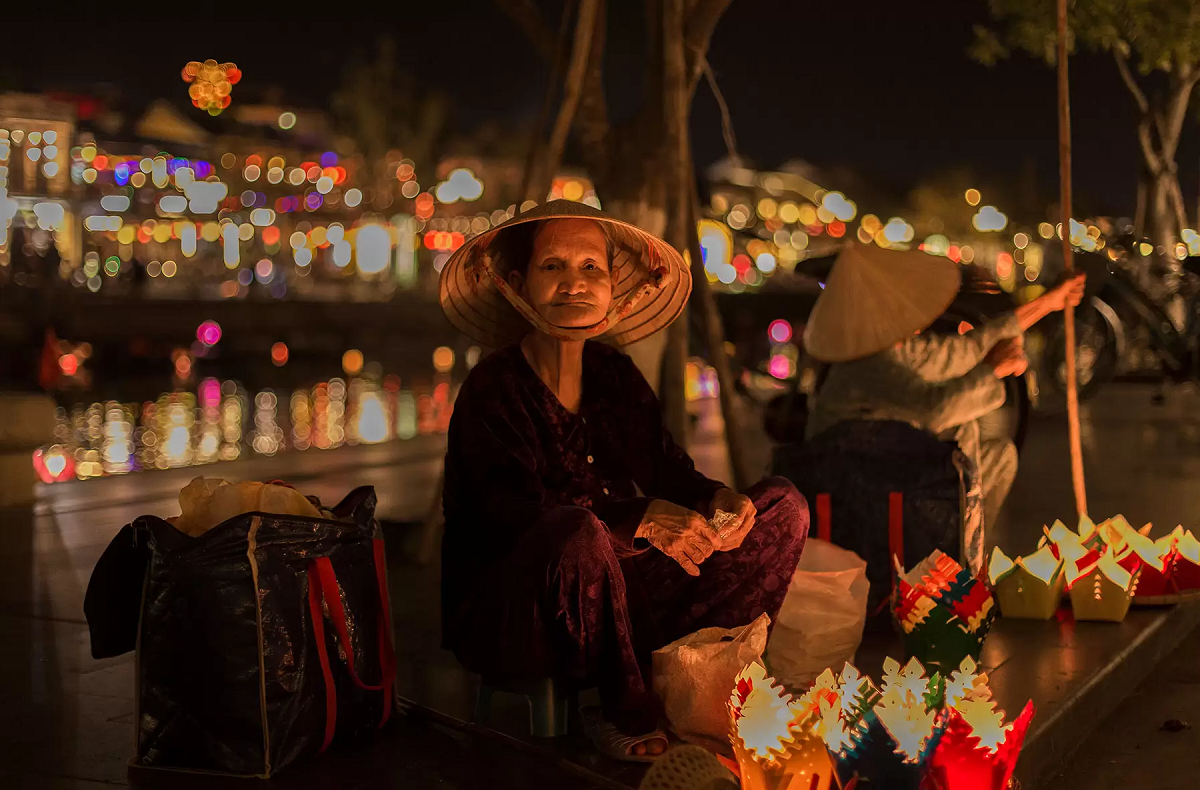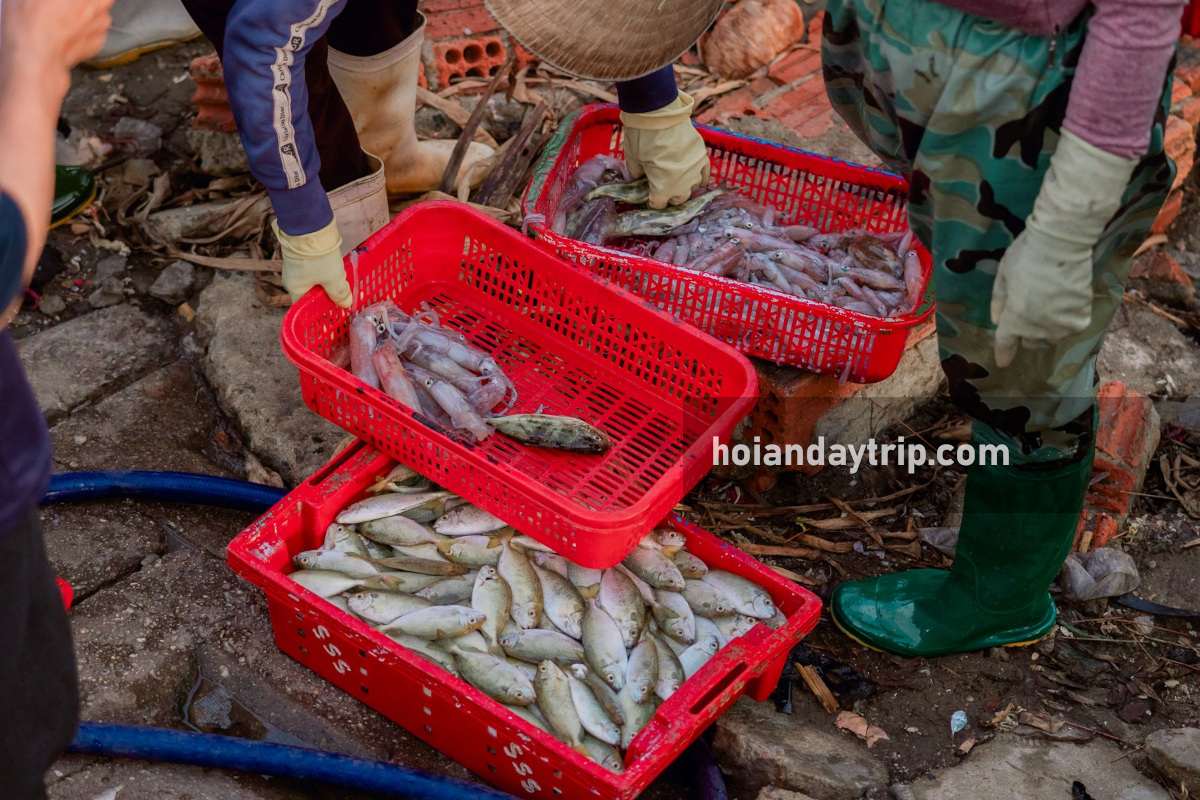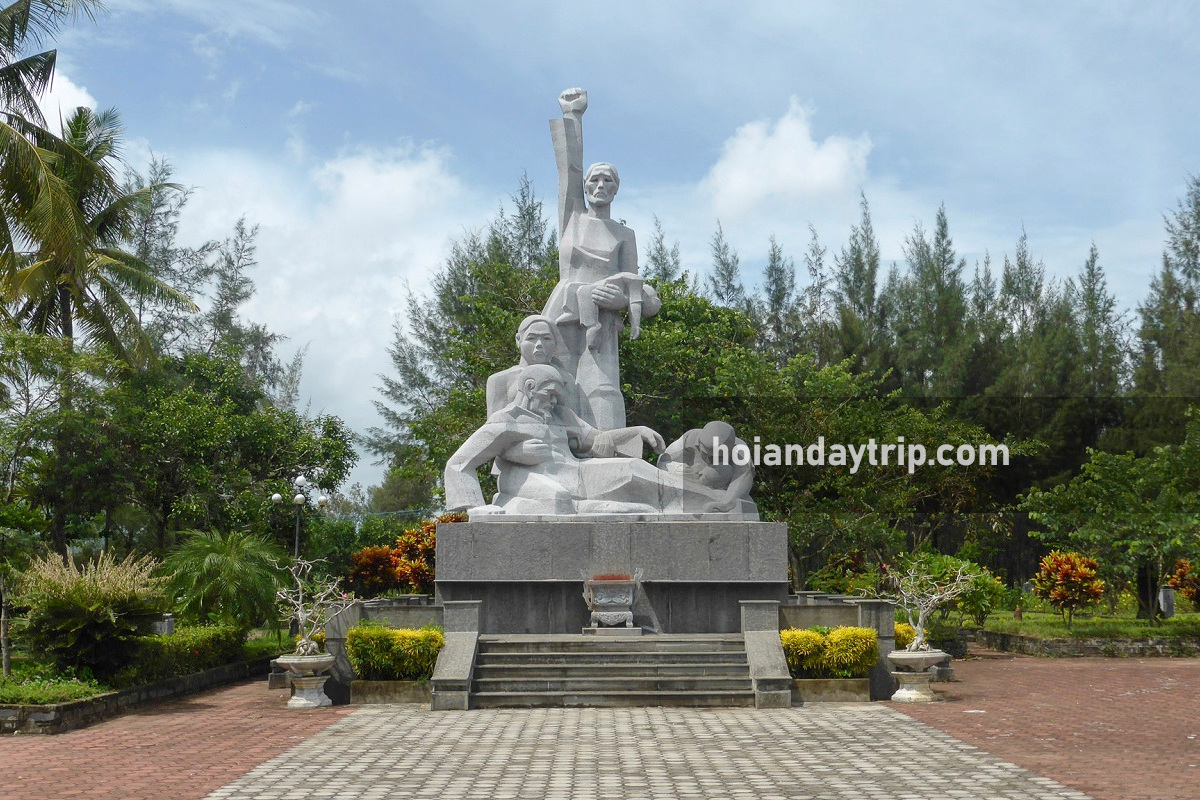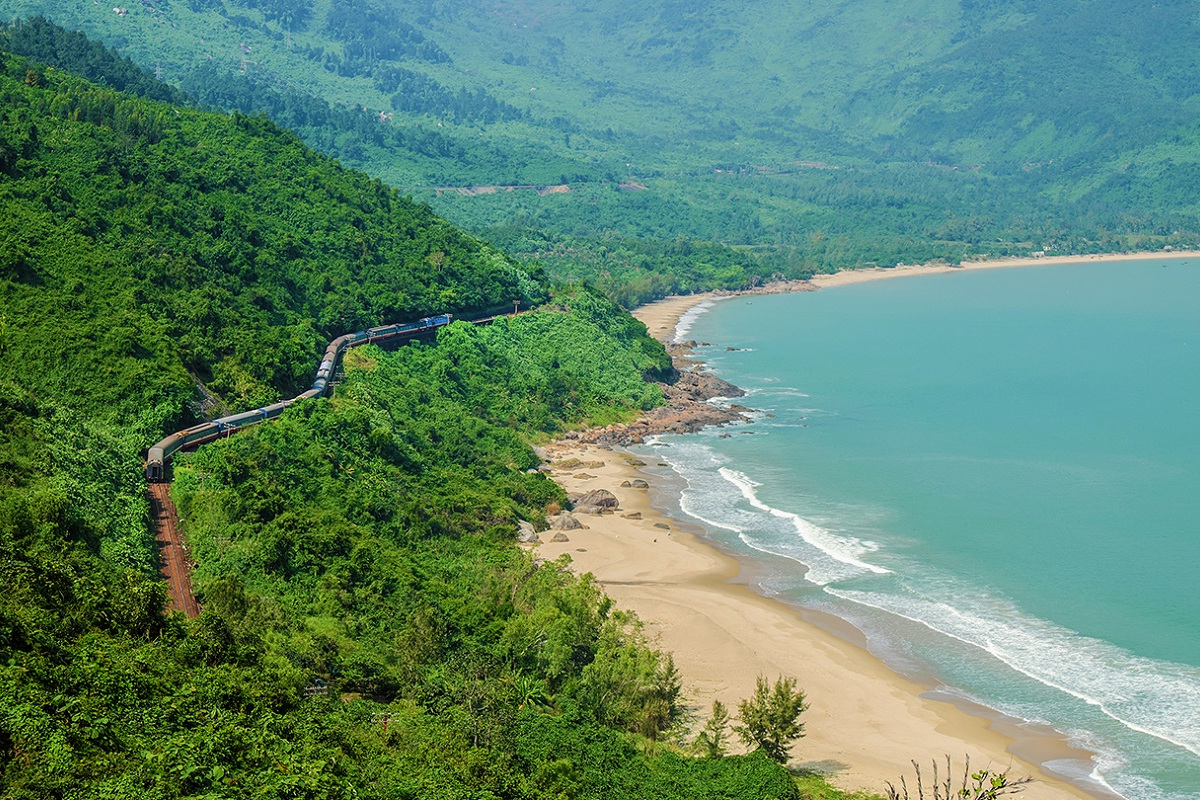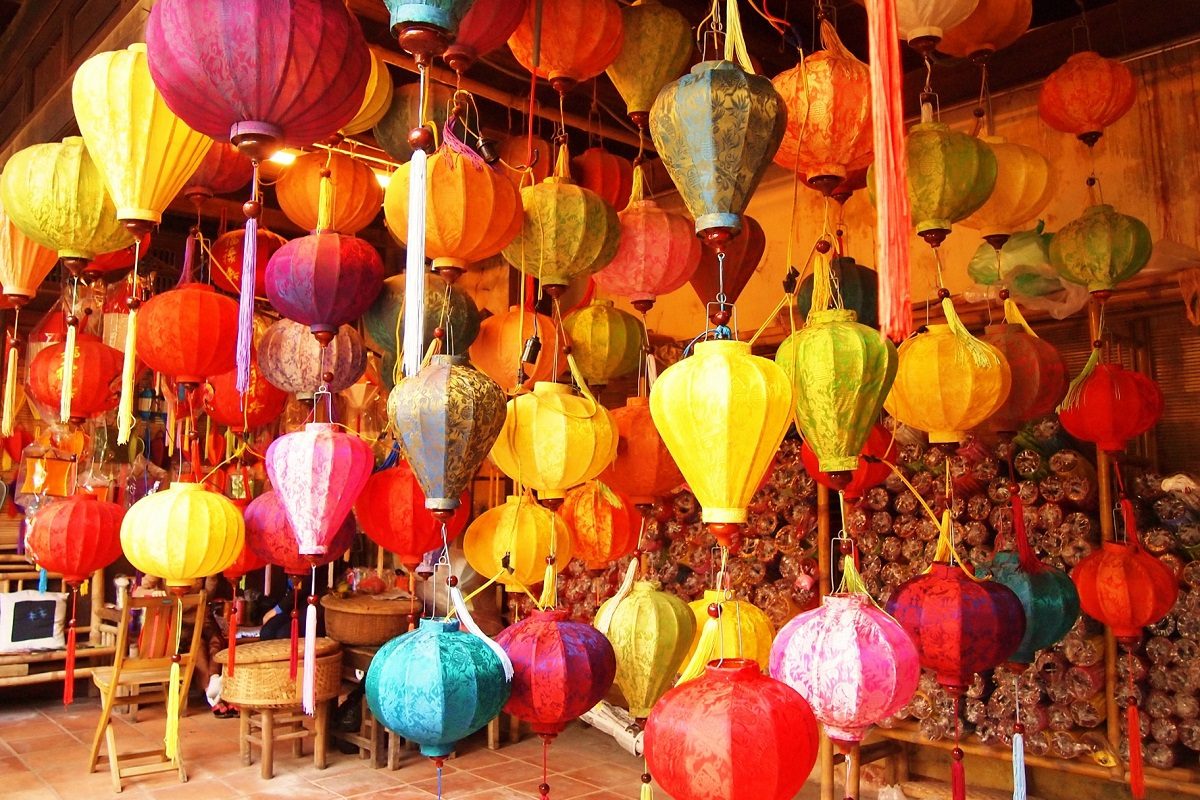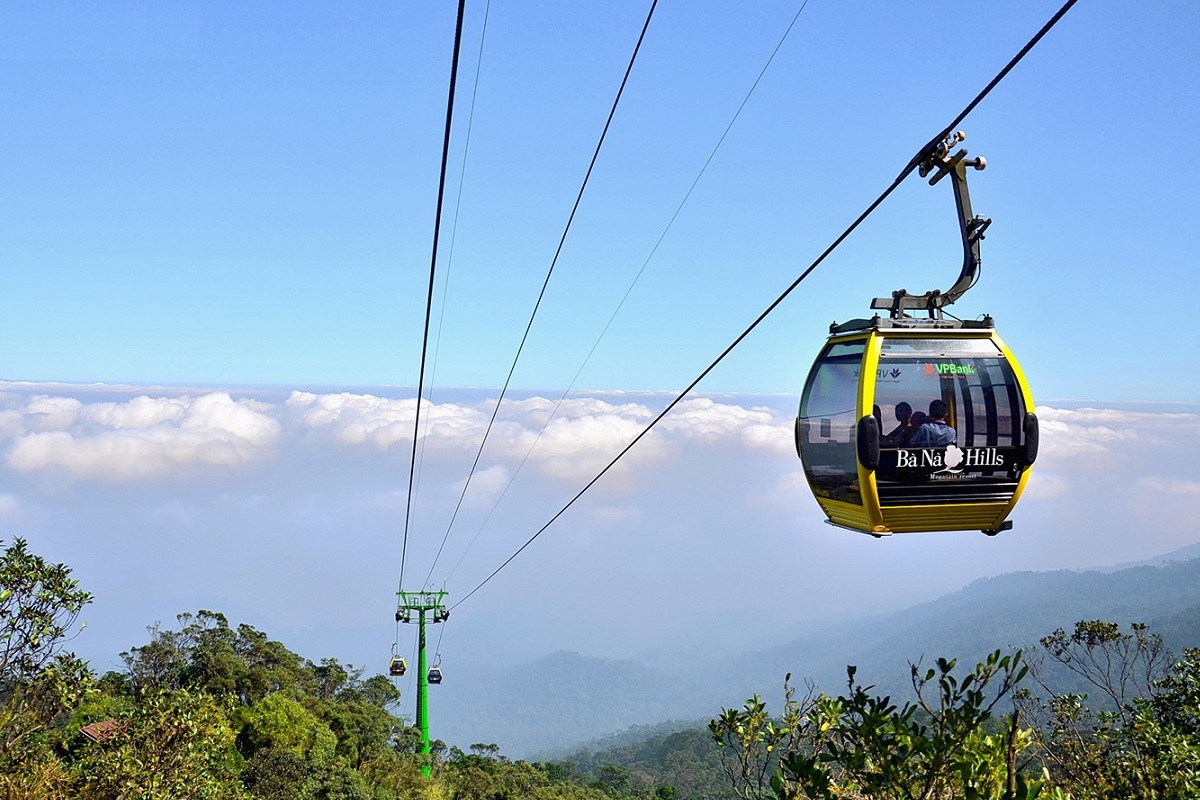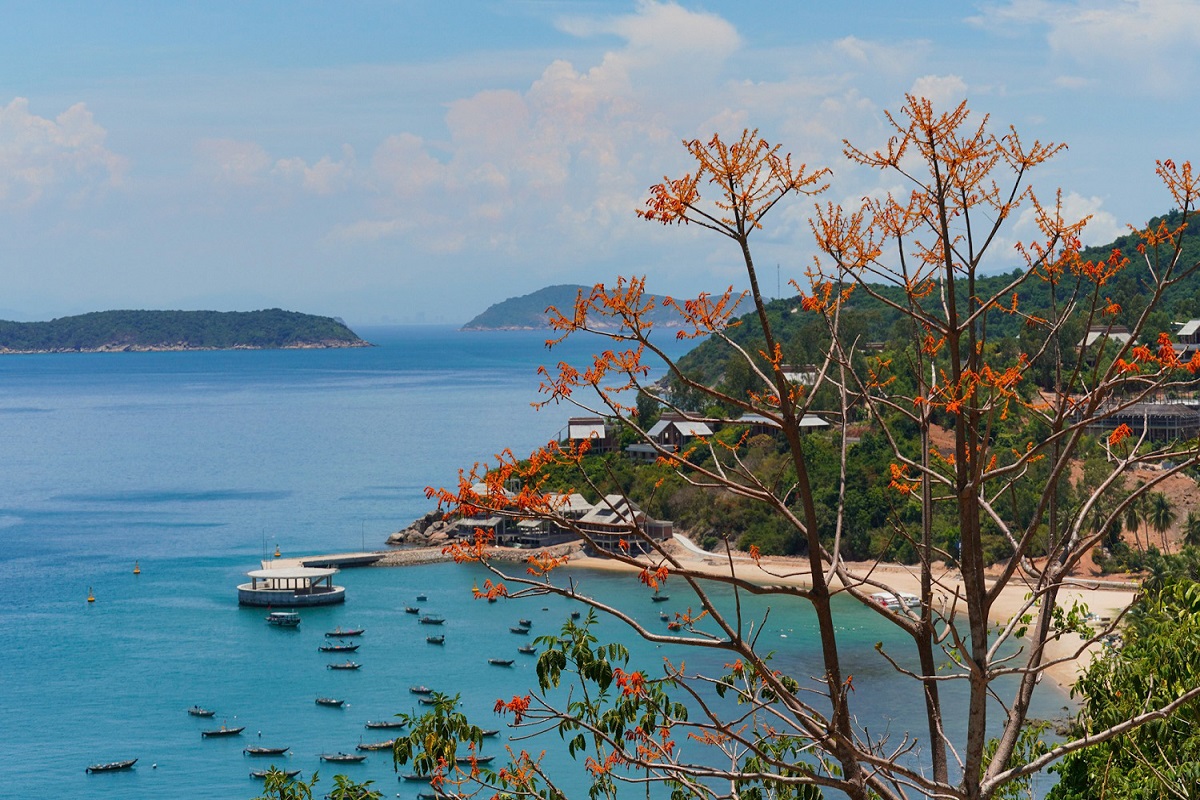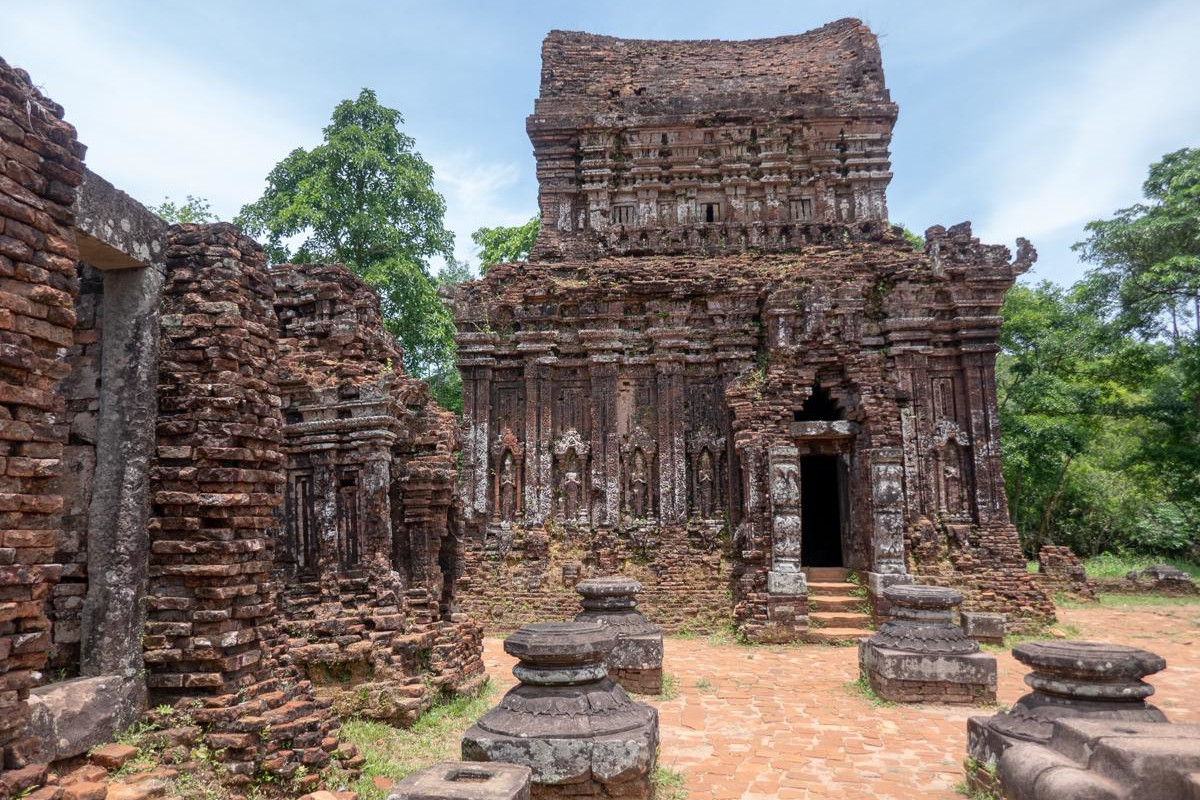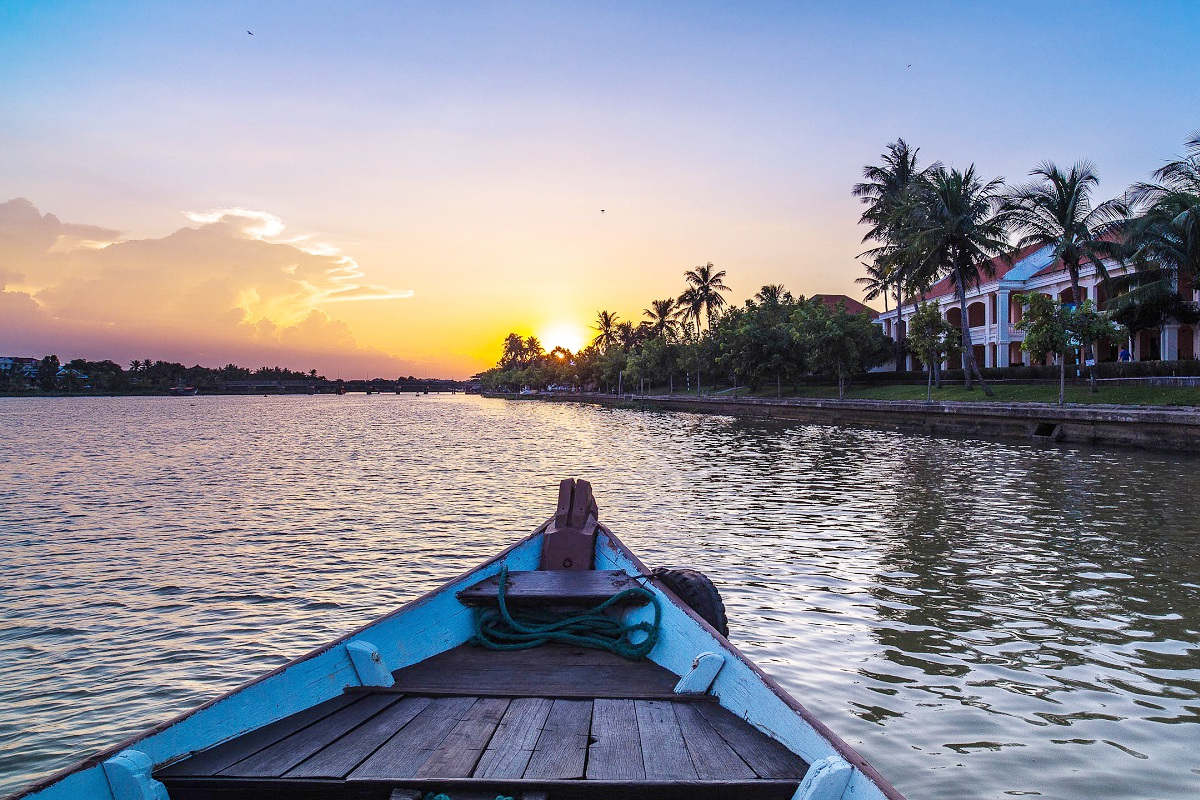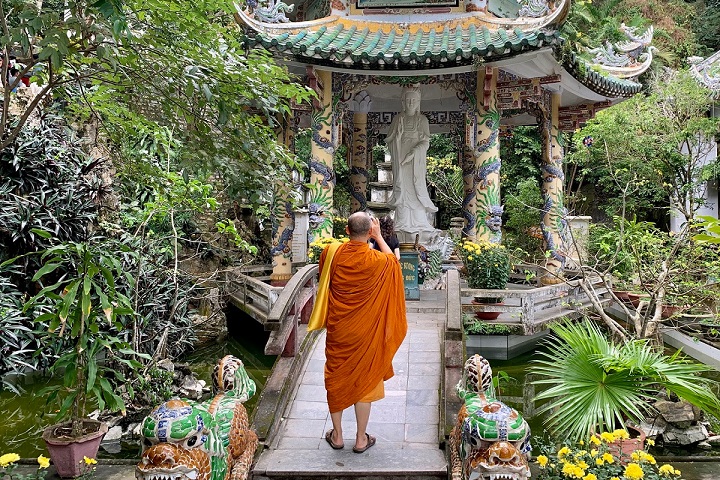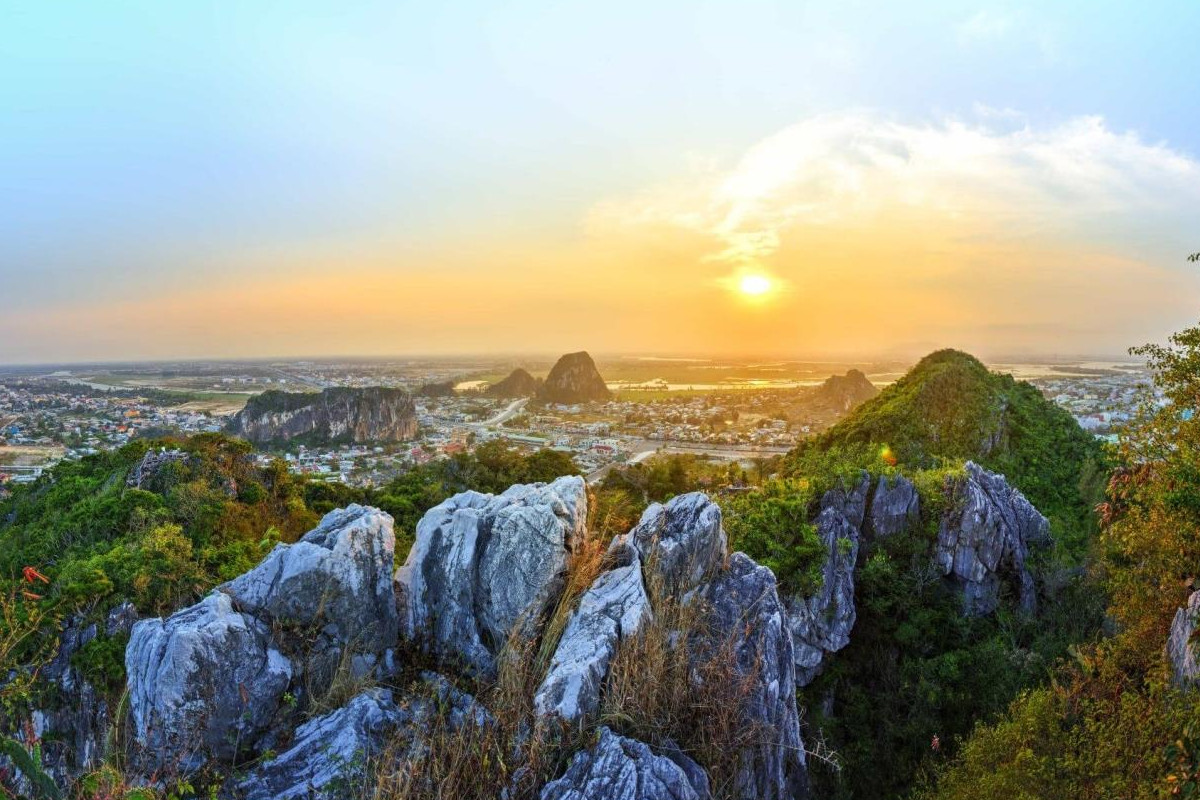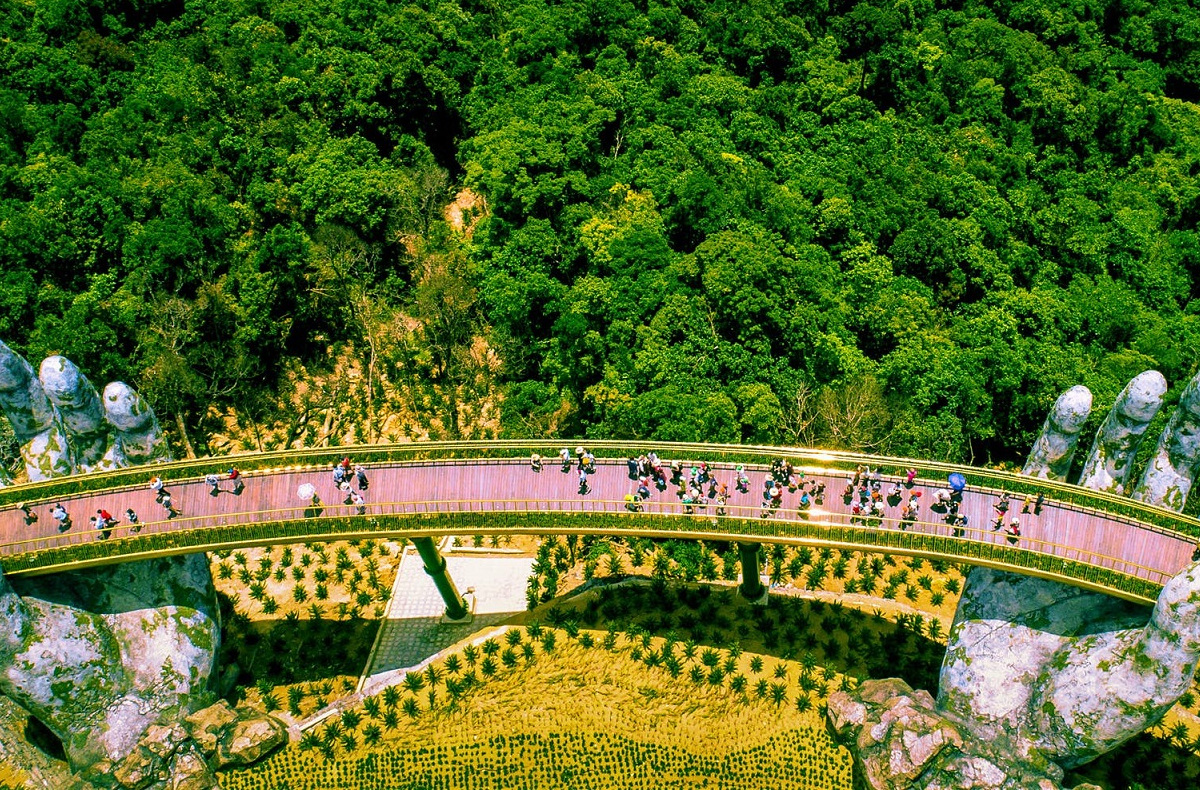Located in a prime location between two famous attractions, the Old Town and An Bang beach, Tra Que vegetable village is a featured point of interest. It’s famous for vegetable growing and good-quality herbs which are a must in many local food specialties. Established a few centuries ago, its name is given from a king. Thanks to peaceful, crowd-free and lush gardens, visitors love to tour around this pretty piece of countryside, by foot or bicycle. It’s easy to see farmers at work and photograph them with the camera.
Tra Que’s vegetable growers have been using unique techniques to produce their herbs. All steps are without chemicals. To understand the farming culture, many visitors come to the village to learn, especially little ones. Farmer experience is among the best bets for a family activity in Hoi An. It’s possible to take part in a hands-on cooking class or herbal massage organized by local families. Both are available and suitable for most members. To keep the entertainment, the beach and lantern-lit town are definitely perfect places to go next. This article outlines all visitors need to know about Tra Que village Hoi An.
See also:
- Countryside around Hoi An – A Complete Guide
- Cam Thanh Coconut Village
- Cam Kim Island and Village
- Hoi An Pottery Village
- Hoi An’s Bicycle Tours

Table of content
- 0.1 An Overview
- 0.2 Tra Que’s Farming Tradition
- 0.3 Tra Que Herbs and Hoi An Food Specialties
- 0.4 Historical Sites
- 0.5 Cau Bong Festival
- 0.6 Touring the Village by Own Way
- 0.7 Farmer Experience
- 0.8 Cooking Class
- 0.9 Herbal Massage
- 0.10 Making Fresh Rice Papers
- 0.11 Tam Huu – Tra Que’s Food Specialty
- 0.12 Baby Mustard
- 0.13 Kum Quat BBQ Restaurant
- 0.14 Tra Que Culinary Village
- 0.15 Sessions Bar Hoi An
- 0.16 Tra Que Mansion
- 0.17 Hoi An Osaka Riverside Villa & Spa
- 0.18 Private Tra Que Village Tour with All Highlights
- 0.19 Half-day Tra Que Village Tour
- 0.20 Full-day Tour Recommendations
- 0.21 An Bang Beach
- 0.22 Hoi An Old Town
- 0.23 Cycling across Countryside around Hoi An
- 1 Tra Que Vegetable Village on Google Maps
- 2 Related Posts
- 3 Bach Ma National Park: Hiking, Trekking in Da Nang and Hoi An
- 4 Hoi An Wet Season: What to Do in Hoi An When It Rains?
- 5 Thanh Ha Terracotta Park
- 6 Vinwonders Nam Hoi An Theme Park (formerly Vinpearl Nam Hoi An)
- 7 Am Phu Cave (Hell Cave) – Things to Do in Da Nang
- 8 Hoi An or Hue: Which is Better?
- 9 The Official Hoi An Travel Guide (MUST READ)
- 10 The Hoi An Market (Hoi An Central Market) Complete Guide
- 11 Hoi An Memories Show: The Best of Hoi An Impression Theme Park
- 12 Hoi An Bridge: Famous Bridges in Hoi An
- 13 How to Get From Hoi An to My Son Sanctuary
- 14 Hoi An’s Chinese Assembly Halls and Chinese Temples
- 15 Hoi An Walking Tours: Heritage, Foods, Photography & Locals
- 16 Hoi An Self Guided Walking Tour – Hoi An On Your Own
- 17 How to Visit Golden Bridge Vietnam
- 18 Unique Experiences in Hoi An and Why?
- 19 An Bang Beach: A Guide to Hoi An’s Best Beach
- 20 Experiences in Hoi An: Get Insight Into Hoi An’s Local Culture
- 21 Things to Do in Ba Na Hills Besides Golden Bridge
- 22 Hoi An Nightlife: What to Do in Hoi An At Night?
- 23 Hoi An Countryside: Villages, Rice Fields & Tours
- 24 How to Get to Golden Bridge From Hoi An
- 25 Hoi An Entrance Fee: Old Town, Golden Bridge, My Son, More
- 26 Hoi An Airport: Everything You Need to Know
- 27 Hoi An Lantern Boat Ride on Hoai River
- 28 Hoi An Private Car and Driver
- 29 What to Do in Hoi An Ancient Town
- 30 Da Nang and Hoi An Itinerary for Visitors Staying Overnight in Hoi An
- 31 Hoi An 3 Day Itinerary: A Travel Plan for 3 Days in Hoi An
- 32 Hoi An Free Things to Do: Budget Travel in Hoi An Vietnam
- 33 Hoi An One Day Itinerary: A Travel Plan for One Day in Hoi An
- 34 Hoi An Half-Day Tours: Guide to Half Day Trips From Hoi An
- 35 Hoi An Day Tours: A Guide to Best Day Trips From Hoi An
- 36 Hoi An Beach: A Guide to All Beaches in Hoi An Vietnam
- 37 Hoi An Food Specialties
- 38 How to Get From Hoi An to Da Nang
- 39 Hoi An Cheap Things to Do: All Solo Travelers Need to Know
- 40 Hoi An Best Things To Do: Recommendations from Local Experts
- 41 Hoi An Things to Do: All What Can You Do in Hoi An Vietnam
- 42 Hoi An Things Not to Miss: A Guide to Must Do in Hoi An
- 43 Hoi An or Da Nang: Which is Better for First Time Visitor?
- 44 Hoi An Pottery Village: A Guide to Thanh Ha Pottery Village
- 45 Hoi An Ancient Town Tour
- 46 Hoi An Old Town Ticket: Price, Sellers, Included Sites, More
- 47 My Son Sanctuary Tour
- 48 Hoi An Lanterns: Festival, Making Class, Where to Buy, More
- 49 Hoi An Best Area to Stay: Guide to Where to Stay in Hoi An
- 50 Hoi An Weather by Month: Guide to Hoi An Monthly Weather
- 51 Hoi An River Cruise: Guide to The Best Boat Tour in Hoi An
- 52 Hoi An Old Town Boats: Guide to Boat Rides in Hoi An Town
- 53 Featured Tours and Experiences
- 53.0.1 Bach Ma National Park Tour from Hue
- 53.0.2 Bach Ma National Park Tour from Da Nang/Hoi An
- 53.0.3 Hoi An Sunrise Fish Market Tour
- 53.0.4 My Lai Massacre Tour
- 53.0.5 Golden Bridge/Ba Na Hills & Hoi An Tour
- 53.0.6 Hoi An Instagram Tour
- 53.0.7 Ky Anh Tunnel & Tam Thanh Mural Village Tour
- 53.0.8 Da Nang to Hue Motorbike Tour with Hai Van Pass & Easy Rider (1 Way)
- 53.0.9 Hue to Da Nang Motorbike Tour with Hai Van Pass & Easy Ride (1 Way)
- 53.0.10 Hue to Hoi An Motorbike Tour with Hai Van Pass & Easy Rider (1 Way)
- 53.0.11 Hoi An to Hue Motorbike Tour with Hai Van Pass & Easy Rider (1 Way)
- 53.0.12 Tra Que Vegetable Village Tour with Cooking Class
- 53.0.13 Ba Na Hills Half Day Tour from Hoi An
- 53.0.14 Marble Mountain & Hoi An Day Tour from Da Nang Port
- 53.0.15 Hue Day Tour from Chan May Port with Lunch
- 53.0.16 Marble Mountain & Hoi An Tour from Chan May Port
- 53.0.17 Ba Na Hills/Golden Bridge Tour from Da Nang Port
- 53.0.18 Ba Na Hills/Golden Bridge Tour from Chan May Port
- 53.0.19 Golden Bridge Private Tour with Ba Na Hills & Lunch
- 53.0.20 Ba Na Hills Afternoon Tour with Golden Hands Bridge
- 53.0.21 Ba Na Hills Private Tour with Golden Hands Bridge
- 53.0.22 Ba Na Hills Half Day Tour with Golden Bridge
- 53.0.23 Ba Na Hills Early Morning Tour to Beat the Crowds
- 53.0.24 Golden Bridge and Ba Na Hills Night Tour
- 53.0.25 Golden Hands Bridge Tour In Sunrise or Sunset (1/2 Day)
- 53.0.26 Cam Kim Island Bicycle Tour From Hoi An
- 53.0.27 Cham Island Tour From Hoi An (Group Tour)
- 53.0.28 Cham Island Tour From Da Nang (Group Tour)
- 53.0.29 Hoi An Vegetarian Food Tour
- 53.0.30 Hoi An Evening Walking Food Tour with Local Foodie
- 53.0.31 Private Hoi An Basket Boat Tour (Shuttle Bus, Bicycle, Bike)
- 53.0.32 Half-day Am Phu Cave Tour (Private)
- 53.0.33 Hoi An Countryside Tour by Electric Car or Bike
- 53.0.34 Da Nang Tour Package From Singapore
- 53.0.35 Hoi An Evening Tour From Da Nang with Lantern Boat Ride
- 53.0.36 Hoi An Walking Food Tour Through Laneways
- 53.0.37 My Son Sanctuary and Hoi An Old Town Tour
- 53.0.38 My Son Day Trip From Hoi An including Marble Mountains and Basket Boat
- 53.0.39 Half Day Hoi An City Tour With River Cruise
- 53.0.40 Son Tra Peninsula Tour with Marble Mountains (Private/Small Group)
- 53.0.41 Hue Day Trip From Hoi An with Hai Van Pass, River Cruise & Lunch
- 53.0.42 Hoi An Ancient Town and Countryside Tour (Bests of Hoi An Tour)
- 53.0.43 Hoi An Tour From Da Nang Airport (Private, Optional Lunch)
- 53.0.44 Hoi An Day Trip From Da Nang (Marble Mountains, Basket Boat, Old Town)
- 53.0.45 Da Nang City Tour From Airport (Private, Optional Lunch)
- 53.0.46 Hoi An City Tour with Lantern Class, Lantern Boat, Night Market & Local Food Sampling
- 53.0.47 Marble Mountains, Basket Boat Ride & Hoi An Old Town Walking Tour
- 53.0.48 Marble Mountains & Golden Bridge/Ba Na Hills Day Tour
- 53.0.49 Marble Mountains & Monkey Mountain Tour (Half-day, Private)
- 53.0.50 Private Golden Bridge Sunrise Tour (Half-day, Optional Lunch)
- 53.0.51 Hoi An Ancient Town & Golden Bridge Day Tour (Private/Small Group)
- 53.0.52 My Son Sanctuary & Golden Bridge/Ba Na Hills Day Tour
- 53.0.53 My Son Sanctuary Sunrise/Early Morning or Sunset Tour
- 53.0.54 Full Day Hoi An Ancient Town & Countryside Experience With Local
- 53.0.55 Full Day My Son Sanctuary & Hoi An Countryside Tour With Local
- 53.0.56 Full Day Hoi An Ancient Town & Coconut Village Experience
- 53.0.57 Son Tra Peninsula, Marble Mountains and Hoi An City Tour
- 53.0.58 Half-day Marble Mountains Tour from Da Nang or Hoi An
- 53.0.59 Da Nang Cave Tour (Half Day Underground Tour in Da Nang)
- 53.0.60 Hoi An Old Town & Lantern Making Class (Morning Tour, Half-day)
An Overview
Between Hoi An old town and An Bang beach, Tra Que vegetable village (or Tra Que herb village) is a fertile island surrounded by the De Vong river. It has green gardens accessed by brick-paved lanes, in the front or back of the houses and a tranquil atmosphere. First inhabitants came to live in 16th century, after the Cham people left and today, there are nearly 280 families. More than a half of households have been growing herbs, vegetables and flowers for local markets and restaurants. Thanks to the use of organic techniques, the quality of these procedures is highest in town. For that reason, Tra Que’s green ingredients are always first choices to chefs and their kitchens. Some traditional dishes require them only. Visitors can expect fun activities in this oasis.
Local people believe that old women selling a handful of bunches of vegetables in the Central market, come from Tra Que village. Experienced wifes often buy something for them.
Tra Que’s Farming Tradition
Thanks to alluvial-rich soil and availability of water all year round, Tra Que village is ideal for farming. Up to date, many of the villagers see vegetable and tree growing as their main source of income. Since when the first seeds were sown, 55 kinds of herb and vegetable have been found in the gardens. Having developed for 400 years, the know-how of Tra Que’s farmers is considered as a national intangible cultural heritage.
According to local farmers, the seeds have to be taken from big and healthy trees in the summer. After that, carefully-selected ones will be dried in the sun for 1 to 3 days, depending on the size. Preparing the soil and fertilizing the young plants are two most important stages then. To make the soil more porous and remove the weed bulbs from previous crops, locals hoe the ground from 40 to 50 centimeters. In the past, there were 10 days needed for solorization but now only a half. Naturally-grown algaes are brought from nearby swamps to fertilize the piece of land. Around a half of a month is needed to wait for algae’s decomposition completely. Now, because of the lack of the algae, animal dung are used to replace it, and therefore, the “waiting time” is down to 5 days. Watering the soil is the next step, requiring one night. After that, the growers till, mould, and transplant the baby vegetables and herbs.
Tra Que Herbs and Hoi An Food Specialties
Hoi An’s signature noodle dishes such as cao lau and mi quang must have Tra Que herbs. The greenages feature smaller sizes but more flavourful than others of their kind. Popularly-used ones are mint, basil, coriander, peppermint, heartleaf herb, parsley, spring onion. Young vegetables are also used to eat with the noodles, like baby mustard, bean sprouts. Especially in case of cao lau, local makers have to have the water from Ba Le well and wood ash in Cham Island.
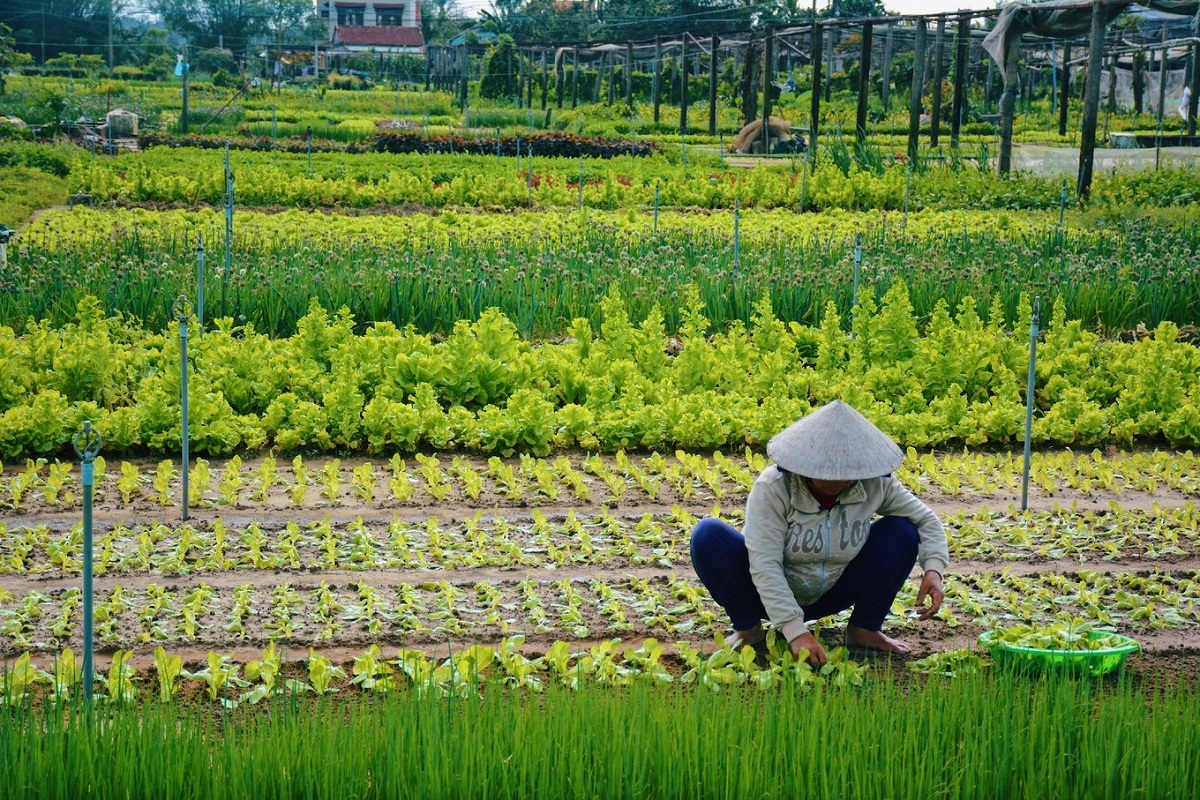
Tra Que village’s island may have been inhabited by Cham people before Vietnamese arrivals from the north in 16th century. To live in the new land, the second population catched fish in the river, the sea and grew vegetables to sell in Hoi An’s central market. At that time, the market was largest in the region where plenty of foreign merchants visited to trade.
From 1964 to 1968, Tra Que village was a revolutionary area of the North Vietnamese army and its inhabitants supported communists during the period. In 1968, the Tet Offensive occurred and became one of turning points in the Vietnam war. There were many people and soldiers lost, so the Americans decided to move the villagers to concentration camps. The aim is to cut the relationship between communists and locals. Because of the strategic location, a Korean marine station was established in the village. 120 soldiers were responsible for protecting Hoi An’s north gateway. In November 1968, the communist’s special forces attacked it and killed 90 of them.
From 1968 to 1975 when Vietnam was unified, Tra Que village faced bombings and many damages. Cultural events and festivals must be stopped, and vegetables grown were mainly for household use. After the war ended, the tradition has continued until now.

Each international visitor will pay 35,000 VND to enter and sightsee around the Tra Que vegetable village. Ticket booths stand in crossroads where Hai Ba Trung Rd meets major ways leading to the gardens and tourist venues. However, it seems that not all visitors purchase this entrance fee in fact.
Historical Sites
Tra Que vegetable village has a 400-years history and some stunning historical and cultural sites to see. One of the oldest relics is the tomb of Nguyen Dien general, built in 1861 after eight years after its owner’s death. The general was borned in the village, and served as a mandarin in the Nguyen dynasty over 3 reigns. He also was responsible for monitoring the construction of two royal tombs. In a short distance, visitors can find an ancient stone well that has been producing the water for many centuries. Historians believe that it’s made by Cham people (like Ba Le well in the Old Town). In the northwest most tip, there are a couple of small temples worshipping the God of the Land and Five-elements Goddess.
Cau Bong Festival
Held on the 7th day of the first lunar month (New year), all members of the Tra Que village participate in this event. Its main purpose is to pray for moderate weather, health, prosperity and luck in life. Each family prepares a boiled chicken with a mouth holding a flower, five-colored sticky rice and a glass of rice wine. In addition to solemn ceremonies, fun games and competitions are also celebrated, including steps to grow vegetables or making Tom huu.

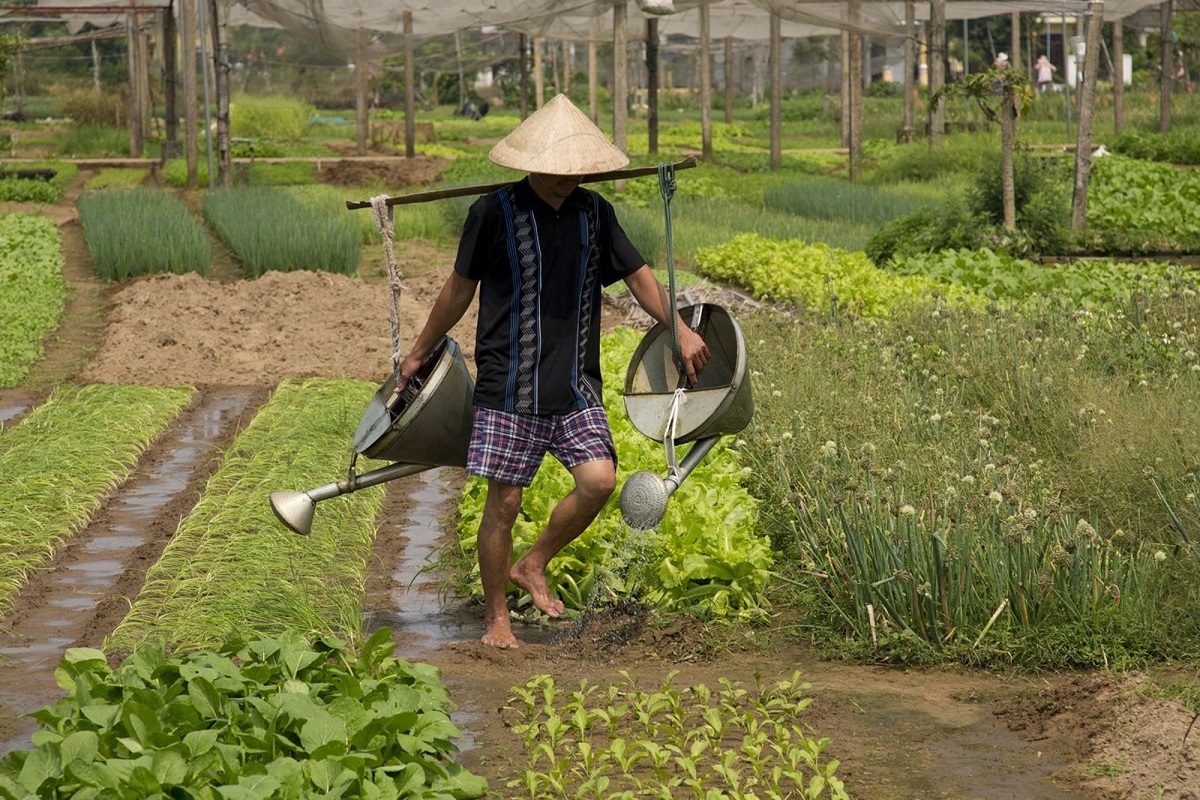
Touring the Village by Own Way
Before stopping at any point of interest, touring the Tra Que vegetable village is a should-try experience. Walking or riding a bicycle is suitable. Slices of life, smiling people and peaceful rural sceneries will be seen, allowing the visitor to escape from busy quarters. It’s not too difficult to navigate the island because it’s quite small and features something that is easy to remember. From the main road Hai Ba Trung, no matter turning left or right, visitors can see vegetable gardens with farmers at work. If aiming to move along the river-edged roads first, take note of brick-paved lanes intersecting them. All lead to herb farms and historical buildings. Looking for nice photos? Early morning is the best time to hunt when locals are in their garden to take care of the plants.
Farmer Experience
Learning techniques to grow vegetables from locals is a featured experience in Tra Que village. In which, visitors at all ages will wear a daily working costume and a conical hat on the head before involving further. Hoeing the ground, tilling, moulding, fertilizing by algaes, transplanting baby vegetables, watering by well water with a carrying pole on the shoulder, covering to protect are instructed by the farmer like how he/she does everyday. There are simple works, but definitely giving a fun time to the whole family, especially the childrens. The host also is a tour guide who introduces different kinds of herb in his/her home garden and shares the name, how the flavour looks like and the use.
Cooking Class
Tra Que village is an ideal place to participate and organize cooking classes. It has a variety of green ingredients that are nice to learn about. Without a market visit, travelers can pick direct, proper ones for cooking later, with advice from locals. Tra Que’s herbs and vegetables are fresh, organically-grown and
Tra Que Water Wheel
This is one of the earliest cooking class organizers in Tra Que village. Now, its best seller class can depart from both morning and afternoon. No matter what, visitors will start the experience with a market visit, to know different local ingredients and interact with the sellers. After a short drive (by taxi or bicycle), the chef instructs the learners how to make delicious dishes using authentic recipes. There are cao lau, mi quang noodles and tam huu, the village’s signature rolls. Price is 450,000 VND per person. If you are in the village already, contact the Tra Que Water Wheel to cut the market visit and transfer.
Telephone number/whatsapp +84905018009 – Email traquewaterwheel@gmail.com
Tra Que Garden Cooking Classs & Restaurant
For visitors in the village already, Tra Que Garden provides two options of cooking class to choose from: at 9:30 a.m and 1:30 p.m. Each lasts 3 hours minimum and includes a menu of several famous Vietnamese dishes, like fresh and fried spring rolls, pancake or banana flower salad. Before spending time with fire and pan, the host takes the learners around the surrounding gardens, to introduce different kinds of herb and vegetable. Some of which are used for cooking later.
Telephone number +849028666603 – Email info@traquegarden.com
Herbal Massage
Locals use useful herbs picked from their home garden, to serve pleasant herbal massages to visitors. Just need to come to tourist venues in the village and ask for the service, no matter whether you are on an organized tour or not. Price is quite affordable and in the same place, it’s possible to look for a local guide who can teach traditional farming techniques or cooking recipes. Thanks to the chilly and fresh environment, many bicycle riders stop here to unwind, select a massage option and relax. In common, a herbal drink (basil seed water commonly) is also provided, as a part of the treatments.
Making Fresh Rice Papers
Some tourist venues (restaurants) organize a small class to guide the visitors on how to make fresh rice paper. Many places use husks like in the past, to boil the water for steaming the rice milk. It’s a fun thing to do, highly recommended to families including childrens who have never experienced it before. In cycling tours to Cam Kim island (south of the Old town), this is an inclusion.
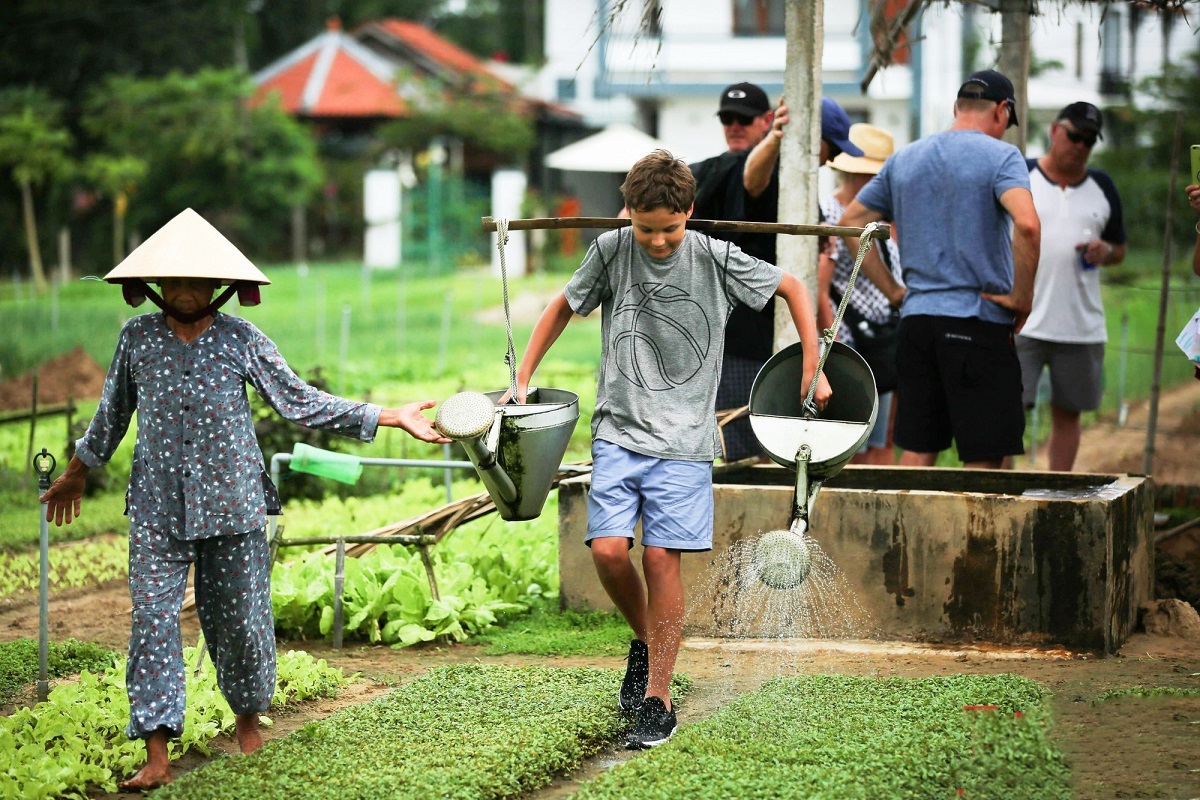

Tam Huu – Tra Que’s Food Specialty
Tam hu or Tom huu in local accents, is the food representation of Tra Que vegetable growing village. Without the rice paper, it’s basically boiled pork, shrimp and raw veggies wrapped together by the spring onion. The name means “three friends”, indicating three major ingredients that are often used in daily meals of local families. In the Cau Bong annual festival, this dish is a must in ceremonies. Today, most restaurants and cooking class organizers can guide visitors further to make or serve directly.
Baby Mustard
Opened in 2012, this restaurant has been run by women for three generations. It serves tasty and authentic Vietnamese foods made by fresh ingredients collected from the home garden. Visitors like the tranquil atmosphere here while enjoying nice flavours, sitting on bamboo chairs under the thatched roof. The owner’s family is very friendly, doesn’t mind sharing knowledge about different herbs.
Opening hours: 11 a.m to 9 p.m daily – Telephone number +84935725749 – Email babymustard.restaurant@gmail.com
Kum Quat BBQ Restaurant
Named the same as a kumquat used to decorate Vietnamese houses every New year, this is a family-owned restaurant. It serves one of the most extensive food menus in the village, with a price ranging from 70,000 to 120,000 VND. The highlights are barbecue, flambe and caramelized meats in clay pot options. There are also 8 set menus available and the list of dishes named in the webpage kumquathoian.com. The price is around 300,000 VND per person. A couple of cocktails and wine can be seen in the menu, but limited now.
Opening hours: 8 a.m to 10 p.m – Telephone number +84989595923 – Email kumquathoian@gmail.com
Tra Que Culinary Village
This venue has the largest ground in the village, including rural architecture and lush vegetation. Not only being the host cooking class, it serves delicious Vietnamese and local-style foods for small to large groups of visitors. Buffet is available, in addition to separate dishes and private dining experiences. Both alcoholic and non-alcoholic beverages are included in the drink menu.
Opening hours: 7 a.m to 10 p.m – Telephone number +842353529789 – Email kumquathoian@gmail.com – Facebook @traqueculinaryvillage
Sessions Bar Hoi An
Under the An Bang bridge, north of the village, this venue caters cold drinks with a killer sunset view on the weekend only. After it’s dark, nice bar snacks and awesome beverages from the bartenders are available until midnight. Many visitors love to unwind here, before visiting a beachfront restaurant to savour fresh seafood.
Opening hours: 5 a.m to 2 p.m – Telephone number +84359343617 – Email sessionsbarhoian@gmail.com – Facebook @sessions.hoian

Tra Que vegetable village is not far from any places around Hoi An. Visitors staying over near the Old town or An Bang beach, often walk to get it. Distance is 3 km and 1,5 km respectively. Between the town and village, windy green rice paddies are either side of the main road Hai Ba Trung. In the sunset, the scenery is breath-taking and loved by plenty of pedestrians and people passing by.
Located in the countryside, Tra Que village is among most stopped places in bicycle itineraries, both self-guided and guided. See recommended routes and packaged tours in our article via centralvietnamguide.com/hoi-an-bike-tour. A short taxi ride is another convenient and quite cheap way to get to Tra Que village. The cost of one four-seat car ranges from 30,000 to 150,000 VND depending on where the visitor sleeps. If needing a taxi to reach the next destination, walking to the main road Hai Ba Trung and raising hands to any.
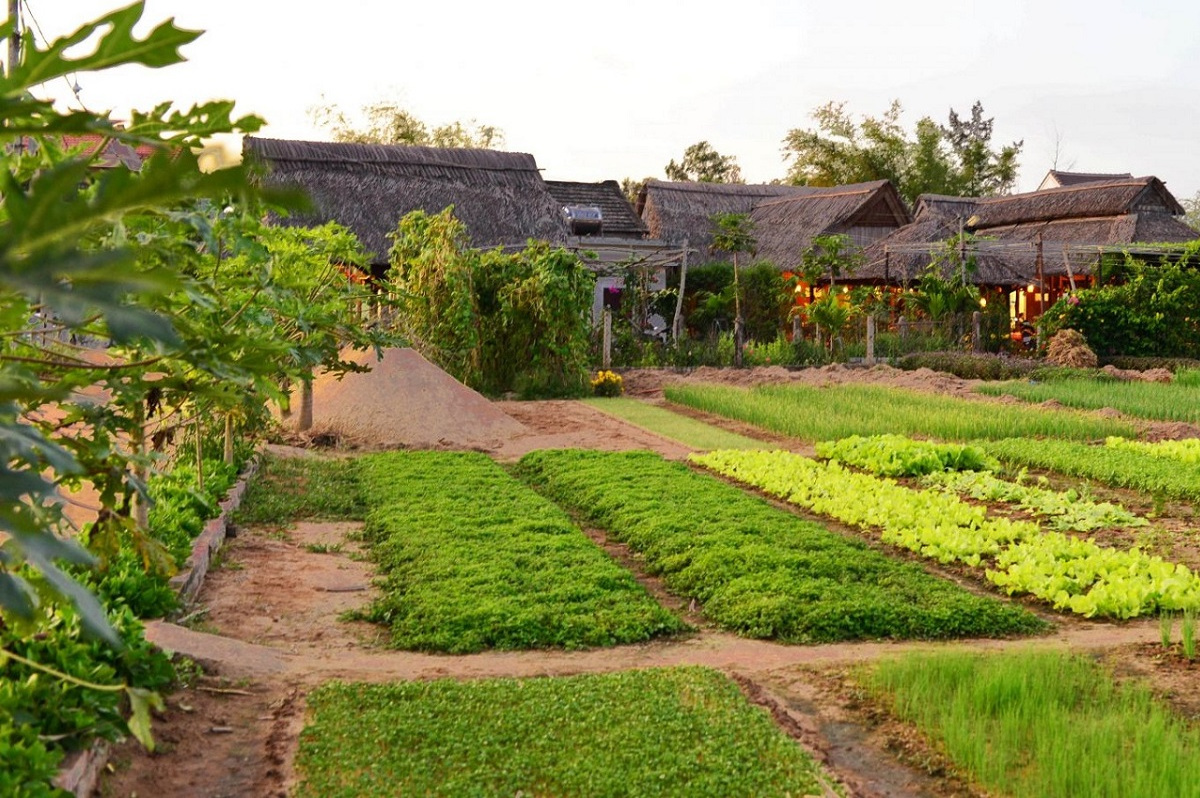
Tra Que village is among the best choices to stay over for those who like to be away from hustle and bustle. Its peaceful, fresh environment and convenient location between the Old town and An Bang beach are definitely strength points. In the evening and early morning, it becomes a calm oasis and there are some awesome activities in later hours.
Tra Que Mansion
At the end of a major road in the northeast of Tra Que vegetable village, this hotel provides beautiful rooms with a swimming pool outside. Each room is air-conditioning, equipped with modern amenities, wireless wifi, and en suite bathroom. From the balcony, peaceful rural sceneries and local life are just in the front. For meals, the guests only need to walk a few minutes to see Vietnamese restaurants surrounded by herb gardens.
Hoi An Osaka Riverside Villa & Spa
Some hundreds of meters away from Hai Ba Trung Rd, this place has comfortable, moderny rooms with fully-equipped interior, swimming pool and lovely surroundings. Its atmosphere is home away from home, and breakfast is made by the owner’s family members every morning. If loving walking to see how life goes on in the village or killer sunset in rice paddies, it takes just a few minutes. Free bicycles are available for free, allowing the guests to have a laid-back ride to the Old town or An Bang beach.
Private Tra Que Village Tour with All Highlights
A private tour with a local guide is fitted to traveling with family. In which, a round trip transfer from the hotel by private car is provided to get to Tra Que village. There, farming experiences in the garden, cooking class and herbal massage are what to expect. After cooking time, all members can sit together and enjoy the dishes just made, besides extra steamed rice and dessert from the host. The Marble Mountains and Non Nuoc marble village are attractions where the visitors can spend the rest of the day well. On the other hand, it’s possible to visit My Son Sanctuary (a Unesco world heritage site) first and then arrive at the village to join in the activity.
To know more details, advice or help to customize your day trip, contact us to make things become easier. Our telephone number/whatsapp number is +84968009827 or email (centralvietnamguide@gmail.com).
Half-day Tra Que Village Tour
Sights, experiences and activities in Tra Que vegetable village are perfect to complete a half day. Visitors can start in the morning or afternoon, tour the village, learn about daily works of farmers, book a cooking class and enjoy lunch or dinner then. While relaxing in a tranquil environment with green gardens in the front, herbal massage is nice to treat yourself. Keep in mind to book cooking class and farmer experience in advance, especially high seasons. Shouldn’t ask for availability when coming because the organizers may close or not actually be ready.
Full-day Tour Recommendations
Things to see and do in Tra Que vegetable village are fitted for half a day. If the hotel in Hoi An, should come in the morning and the afternoon visit is better for Da Nang stayers. Tour packages in Hoi An are more diverse, because of a much shorter distance, from tours by car, bicycle, motorcycle to jeep. My Son Sanctuary or Marble Mountains are the best places to visit, to combine with. To save time, contact us to know advice, tips and recommendations, or find a knowledgeable guide. Our whatsapp +84968009827 or centralvietnamguide@gmail.com.

An Bang Beach
This stretch of fine sandy coast is only 1,5 km to the north of Tra Que village. By the clear and unpolluted water, visitors can find many sun beds to relax, spaces to lounge in the sun and seafront venues to eat and drink. In the evening, live music restaurants and late-night bars are the highlight of An Bang’s nightlife. Read our own guide centralvietnamguide.com/an-bang-beach for further information.
Hoi An Old Town
3km south of the village, Hoi An Old Town is the largest tourist hub in the region. No matter day hours or the evening, visitors can find stunning things to see and fun activities to participate in. If you don’t have much time, make sure that there is a half day available to discover highlights there. After the sun disappears, lanterns are lit up and all streets look so gorgeous, really outstanding. Nearby night market has many options of street food to try and cheap souvenirs to buy. Everything about this amazing destination is outlined in our ultimate travel guide centralvietnamguide.com/hoi-an-old-town.
Cycling across Countryside around Hoi An
Traveling with a bicycle across the pretty and tranquil countryside around Hoi An town is interesting. As a famous place, self-guided and guided cycling tours recommend at least riding leisurely across at least. Farming or cooking experiences may be included, depending on different itineraries. Two most popular plans are to explore An Bang beach or Cam Thanh’s coconut village after visiting the Tra Que vegetable village. Read our own article for bicycle tours in Hoi An via centralvietnamguide/hoi-an-bike-tour, to know more information to design your exploration easier.

Tra Que Vegetable Village on Google Maps
Related Posts
Bach Ma National Park: Hiking, Trekking in Da Nang and Hoi An
Two best places for trekking and hiking in and near Da Nang are Son Tra mountain (peninsula) and Bach Ma national park. Which one is better is actually personal because these
Hoi An Wet Season: What to Do in Hoi An When It Rains?
No beach, no pool, no outdoor adventures? What to do in Hoi An when it rains? This is a very popular question from travelers who come to Vietnam in the
Thanh Ha Terracotta Park
Between 15th and 19th centuries, Hoi An was one of major stopovers for sailing merchants to trade in Southeast Asia. Meanwhile, craftspeople in its Thanh Ha village produce high-quality pottery
Vinwonders Nam Hoi An Theme Park (formerly Vinpearl Nam Hoi An)
In addition to historical and cultural attractions, nowadays Hoi An also has a couple of amusement parks to entertain. Definitely, they’re ideal places for families with children and groups of
Am Phu Cave (Hell Cave) – Things to Do in Da Nang
Although in the Marble mountains – the most visited attraction in Da Nang, travelers often miss Am Phu cave. One of reasons is that it’s mentioned much online and not
Hoi An or Hue: Which is Better?
Both Hoi An and Hue cities are in the middle of Vietnam, and they’re not far from each other (about 130 km). Therefore, for those who travel from north to
The Official Hoi An Travel Guide (MUST READ)
By the estuary of Thu Bon river, Hoi An is one of the best places to visit in Vietnam. This Vietnamese town is a package for travelers – a pretty
The Hoi An Market (Hoi An Central Market) Complete Guide
The Hoi An Market is the first market in Hoi An ever. Over centuries, it’s still the largest market in town although the town has a much bigger size than
Hoi An Memories Show: The Best of Hoi An Impression Theme Park
The Hoi An Memories Show is a famous series of outdoor performances in Hoi An at the present time. Thanks to its exceptional production and great cultural stories, it becomes
Hoi An Bridge: Famous Bridges in Hoi An
Hoi An has many bridges because it’s located at the confluence of 3 rivers: Thu Bon river, De Vong river and Truong Giang “Long river”. The distributaries of these rivers
How to Get From Hoi An to My Son Sanctuary
My Son sanctuary is one of the most popular places to visit for tourists staying overnight in Hoi An, especially those who spend many days there. It’s known for a
Hoi An’s Chinese Assembly Halls and Chinese Temples
Chinese people migrated to Hoi An from the early 17th century. Today, Chinese communities as a whole are the second most important piece to form the town’s unique culture. The foremost
Hoi An Walking Tours: Heritage, Foods, Photography & Locals
Strolling around heritage quarters with a local guide is the activity that so many travelers love to do in Hoi An. It enriches their time in this lovely town. Firstly,
Hoi An Self Guided Walking Tour – Hoi An On Your Own
Hoi An old town is friendly for pedestrians, especially during the time that motorized vehicles (scooters, cars, etc) are prohibited to move around its heritage quarters. That is safe for
How to Visit Golden Bridge Vietnam
The Golden Hand Bridge of Ba Na hills today is a dream place to visit for many travelers. Since it opened in June 2018, millions of people have set their
Unique Experiences in Hoi An and Why?
Today, travelers seek more experiences in the destination they go to. They want to have a deeper understanding about the culture of local people and interact with them. No other
An Bang Beach: A Guide to Hoi An’s Best Beach
An Bang beach now becomes a popular tourist attraction in Hoi An. It may be the best known and most convenient to reach from the town’s centre. Not only tourists,
Experiences in Hoi An: Get Insight Into Hoi An’s Local Culture
As the most unique Vietnamese town, Hoi An is definitely worth visiting. Here, visitors have many things to do and experiences for their holiday time. Everyone knows that it has
Things to Do in Ba Na Hills Besides Golden Bridge
According to local authorities, 50% of visitors coming to Da Nang and Hoi An visit the Ba Na hills. In other words, that is nearly 10 millions of people. This
Hoi An Nightlife: What to Do in Hoi An At Night?
After dark, Hoi An becomes exceptionally spectacular. If planning to stay overnight or visiting this ancient heritage town, at least travelers know that it’s “decorated” by so many colorful lanterns.
Hoi An Countryside: Villages, Rice Fields & Tours
By the coast, Hoi An is at the confluence of 3 rivers: Thu Bon river, Truong Giang river and De Vong river. This economically strategic location has supported trading activities
How to Get to Golden Bridge From Hoi An
There are many travelers visiting the Golden bridge from Hoi An. Both the bridge and the town today are must-see places in the region, so staying overnight in the town
Hoi An Entrance Fee: Old Town, Golden Bridge, My Son, More
Are you planning to visit Hoi An? And you don’t know how much cash you need to prepare for visiting places? This article lists tourist attractions in Hoi An and
Hoi An Airport: Everything You Need to Know
Hoi An is a famous tourist city in Vietnam. It’s 800 kilometers away from Hanoi, the capital of Vietnam and nearly 1,000 kilometers from Ho Chi Minh city, the biggest
Hoi An Lantern Boat Ride on Hoai River
A lantern boat ride is a thing to do that visitors must do today in Hoi An. For many centuries, locals have taken it on the Hoai river by the
Hoi An Private Car and Driver
Hoi An is one of the most popular tourist destinations in Vietnam. In the busiest year, it attracts about 9 millions visitors who come to enjoy its charming beauty, rich
What to Do in Hoi An Ancient Town
Hoi An Ancient Town is a must see, not only thanks to its world heritage title, but also to its vintage urban landscape, lots of attractions and activities. In the
Da Nang and Hoi An Itinerary for Visitors Staying Overnight in Hoi An
Da Nang and Hoi An are twin cities in the heart of Central Vietnam. Both are popular tourist destinations for either domestic or international visitors, and share many similarities. Due
Hoi An 3 Day Itinerary: A Travel Plan for 3 Days in Hoi An
3 days are a perfect duration to stay overnight in Hoi An and explore captivating places in and around it. Especially for those who travel from city to city or
Hoi An Free Things to Do: Budget Travel in Hoi An Vietnam
Travelers should know free things to do in Hoi An, to save the budget for this wonderful city and by that, can stay longer to explore. From old town, countryside
Hoi An One Day Itinerary: A Travel Plan for One Day in Hoi An
From a backwater town in the 1990s, Hoi An today is one of leading tourist destinations across Vietnam. In a recent year, it attracted 8,5 millions of overnight visitors and
Hoi An Half-Day Tours: Guide to Half Day Trips From Hoi An
Top attractions near Hoi An require a couple of hours or half a day, to get there and visit around. The reason is that all have many things to see,
Hoi An Day Tours: A Guide to Best Day Trips From Hoi An
Near Hoi An, there are many fantastic places making travelers can’t stay in the room and have to go out to explore. Appeal Golden bridge – the new world wonder,
Hoi An Beach: A Guide to All Beaches in Hoi An Vietnam
Not only an old town, Hoi An has beaches as well! That are sandy, edged by tropical water and lined by palm forests. Travelers don’t need to wait or move
Hoi An Food Specialties
Hoi An is a melting pot where people from different parts of Vietnam and countries in the world have gathered and exchanged their cultures. As a result, this town has
How to Get From Hoi An to Da Nang
Da Nang is the neighbouring city of Hoi An. It's the capital of Central Vietnam and has the most important (busiest) transport hubs of the region, such as airport, train
Hoi An Cheap Things to Do: All Solo Travelers Need to Know
Knowing free and cheap things to do in the city where travelers are going to visit, is helpful. First of all, they can save and, thanks to that, can stretch
Hoi An Best Things To Do: Recommendations from Local Experts
It is no coincidence that Hoi An is in the list of must-visit places once in the lifetime of many travelers. Located by a river, it’s borned to welcome people
Hoi An Things to Do: All What Can You Do in Hoi An Vietnam
Hoi An is in the bucket list of most travellers who plan to visit the Central part of Vietnam. It’s a lovely old and small town located downstream of a
Hoi An Things Not to Miss: A Guide to Must Do in Hoi An
In fact, there are so many things to do in Hoi An, one of the 10 best cities in Asia by Travel + Leisure in 2021. It has a lantern-filled
Hoi An or Da Nang: Which is Better for First Time Visitor?
Da Nang and Hoi An are located in Central Vietnam, with a distance of roughly 30 km. To the north, Da Nang is the capital city of the region, with
Hoi An Pottery Village: A Guide to Thanh Ha Pottery Village
Hoi An used to be a bustling, prosperous trade port during past centuries, before its role was replaced by Da Nang. Merchants from many countries on different continents came here
Hoi An Ancient Town Tour
Hoi An Ancient Town is a Unesco world heritage site by the mouth of the Thu Bon River. It has grid-plan streets filled by silk lanterns and bougainvillea flowers that
Hoi An Old Town Ticket: Price, Sellers, Included Sites, More
As an attraction including attractions, Hoi An Old Town requires an entrance ticket to tourists who come from other parts of Vietnam and the world. It raises funds for preservation of
My Son Sanctuary Tour
My Son Sanctuary is a Unesco world heritage site, attracting 450,000 visitors in recent years. It’s the best remains left by the fallen Champa Kingdom which ruled a part of
Hoi An Lanterns: Festival, Making Class, Where to Buy, More
Lanterns are the signature of Hoi An Old Town, the 3rd Unesco world heritage site in Vietnam. Especially at night, these traditional handicraft objects are lit up and make the town
Hoi An Best Area to Stay: Guide to Where to Stay in Hoi An
In the busiest year, nearly 5,5 millions travellers decided to stay overnight in Hoi An. It’s the largest number that a city in the Central coast of Vietnam ever achieved.
Hoi An Weather by Month: Guide to Hoi An Monthly Weather
Hoi An won the title “Asia’s leading cultural destination” recently in a reputable global travel award. It’s a pretty riverine-coastal town with an ancient root, surrounded by peaceful pieces of
Hoi An River Cruise: Guide to The Best Boat Tour in Hoi An
Hoi An town is by the left bank of the Thu Bon River, and by that, it draws plenty of merchants by sailing boat to visit and trade. Its golden
Hoi An Old Town Boats: Guide to Boat Rides in Hoi An Town
Hoi An town sits by the left bank of the Thu Bon River, the largest and most important waterway in mother Quang Nam province. It’s also near the mouth of


